Jilong Wu
Get Large Language Models Ready to Speak: A Late-fusion Approach for Speech Generation
Oct 27, 2024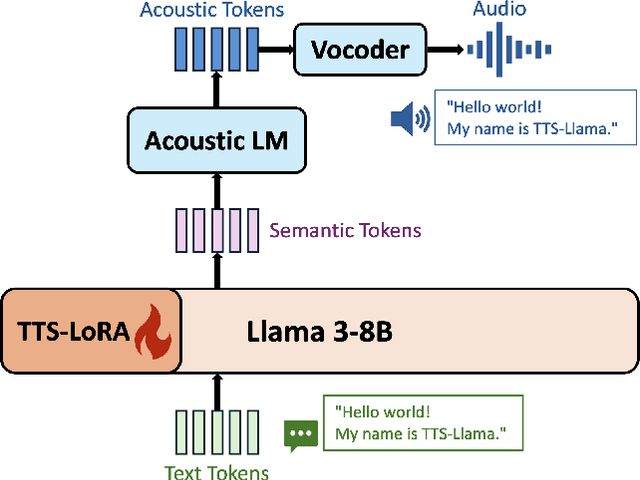
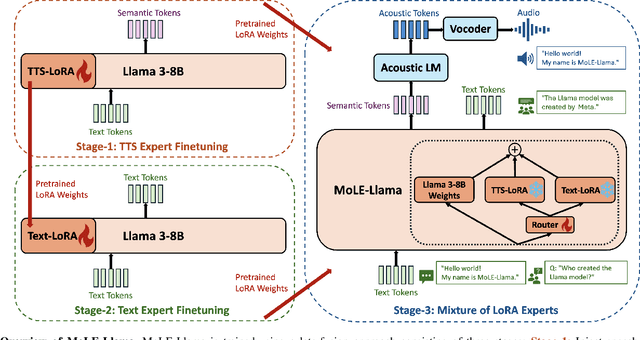
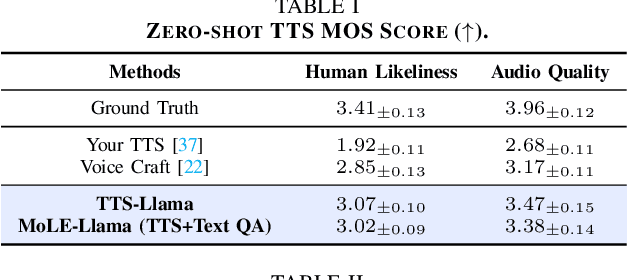
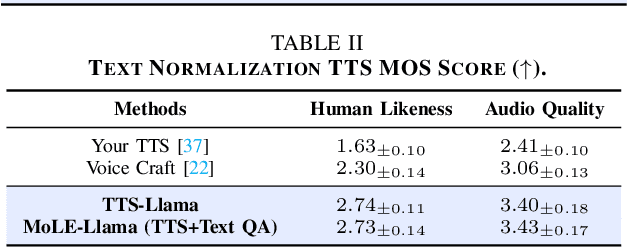
Abstract:Large language models (LLMs) have revolutionized natural language processing (NLP) with impressive performance across various text-based tasks. However, the extension of text-dominant LLMs to with speech generation tasks remains under-explored. In this work, we introduce a text-to-speech (TTS) system powered by a fine-tuned Llama model, named TTS-Llama, that achieves state-of-the-art speech synthesis performance. Building on TTS-Llama, we further propose MoLE-Llama, a text-and-speech multimodal LLM developed through purely late-fusion parameter-efficient fine-tuning (PEFT) and a mixture-of-expert architecture. Extensive empirical results demonstrate MoLE-Llama's competitive performance on both text-only question-answering (QA) and TTS tasks, mitigating catastrophic forgetting issue in either modality. Finally, we further explore MoLE-Llama in text-in-speech-out QA tasks, demonstrating its great potential as a multimodal dialog system capable of speech generation.
Self-Supervised Representations for Singing Voice Conversion
Mar 21, 2023Abstract:A singing voice conversion model converts a song in the voice of an arbitrary source singer to the voice of a target singer. Recently, methods that leverage self-supervised audio representations such as HuBERT and Wav2Vec 2.0 have helped further the state-of-the-art. Though these methods produce more natural and melodic singing outputs, they often rely on confusion and disentanglement losses to render the self-supervised representations speaker and pitch-invariant. In this paper, we circumvent disentanglement training and propose a new model that leverages ASR fine-tuned self-supervised representations as inputs to a HiFi-GAN neural vocoder for singing voice conversion. We experiment with different f0 encoding schemes and show that an f0 harmonic generation module that uses a parallel bank of transposed convolutions (PBTC) alongside ASR fine-tuned Wav2Vec 2.0 features results in the best singing voice conversion quality. Additionally, the model is capable of making a spoken voice sing. We also show that a simple f0 shifting scheme during inference helps retain singer identity and bolsters the performance of our singing voice conversion model. Our results are backed up by extensive MOS studies that compare different ablations and baselines.
Synthetic Cross-accent Data Augmentation for Automatic Speech Recognition
Mar 01, 2023


Abstract:The awareness for biased ASR datasets or models has increased notably in recent years. Even for English, despite a vast amount of available training data, systems perform worse for non-native speakers. In this work, we improve an accent-conversion model (ACM) which transforms native US-English speech into accented pronunciation. We include phonetic knowledge in the ACM training to provide accurate feedback about how well certain pronunciation patterns were recovered in the synthesized waveform. Furthermore, we investigate the feasibility of learned accent representations instead of static embeddings. Generated data was then used to train two state-of-the-art ASR systems. We evaluated our approach on native and non-native English datasets and found that synthetically accented data helped the ASR to better understand speech from seen accents. This observation did not translate to unseen accents, and it was not observed for a model that had been pre-trained exclusively with native speech.
Voice-preserving Zero-shot Multiple Accent Conversion
Nov 23, 2022Abstract:Most people who have tried to learn a foreign language would have experienced difficulties understanding or speaking with a native speaker's accent. For native speakers, understanding or speaking a new accent is likewise a difficult task. An accent conversion system that changes a speaker's accent but preserves that speaker's voice identity, such as timbre and pitch, has the potential for a range of applications, such as communication, language learning, and entertainment. Existing accent conversion models tend to change the speaker identity and accent at the same time. Here, we use adversarial learning to disentangle accent dependent features while retaining other acoustic characteristics. What sets our work apart from existing accent conversion models is the capability to convert an unseen speaker's utterance to multiple accents while preserving its original voice identity. Subjective evaluations show that our model generates audio that sound closer to the target accent and like the original speaker.
Towards zero-shot Text-based voice editing using acoustic context conditioning, utterance embeddings, and reference encoders
Oct 28, 2022



Abstract:Text-based voice editing (TBVE) uses synthetic output from text-to-speech (TTS) systems to replace words in an original recording. Recent work has used neural models to produce edited speech that is similar to the original speech in terms of clarity, speaker identity, and prosody. However, one limitation of prior work is the usage of finetuning to optimise performance: this requires further model training on data from the target speaker, which is a costly process that may incorporate potentially sensitive data into server-side models. In contrast, this work focuses on the zero-shot approach which avoids finetuning altogether, and instead uses pretrained speaker verification embeddings together with a jointly trained reference encoder to encode utterance-level information that helps capture aspects such as speaker identity and prosody. Subjective listening tests find that both utterance embeddings and a reference encoder improve the continuity of speaker identity and prosody between the edited synthetic speech and unedited original recording in the zero-shot setting.
VocBench: A Neural Vocoder Benchmark for Speech Synthesis
Dec 06, 2021
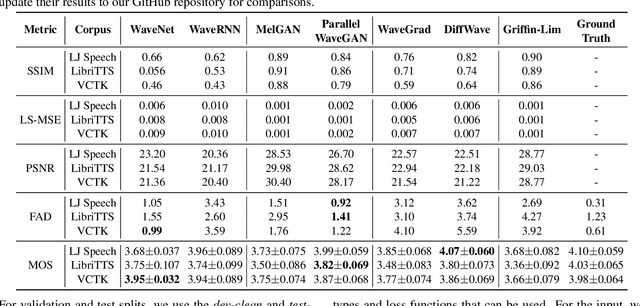

Abstract:Neural vocoders, used for converting the spectral representations of an audio signal to the waveforms, are a commonly used component in speech synthesis pipelines. It focuses on synthesizing waveforms from low-dimensional representation, such as Mel-Spectrograms. In recent years, different approaches have been introduced to develop such vocoders. However, it becomes more challenging to assess these new vocoders and compare their performance to previous ones. To address this problem, we present VocBench, a framework that benchmark the performance of state-of-the art neural vocoders. VocBench uses a systematic study to evaluate different neural vocoders in a shared environment that enables a fair comparison between them. In our experiments, we use the same setup for datasets, training pipeline, and evaluation metrics for all neural vocoders. We perform a subjective and objective evaluation to compare the performance of each vocoder along a different axis. Our results demonstrate that the framework is capable of showing the competitive efficacy and the quality of the synthesized samples for each vocoder. VocBench framework is available at https://github.com/facebookresearch/vocoder-benchmark.
Multi-rate attention architecture for fast streamable Text-to-speech spectrum modeling
Apr 01, 2021
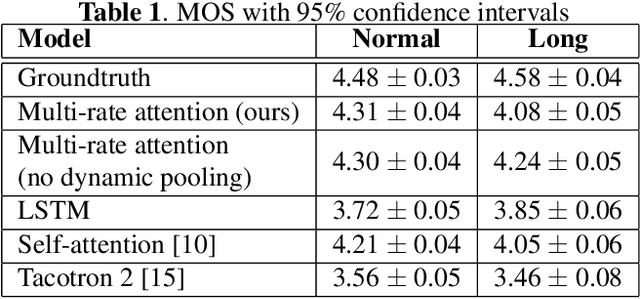
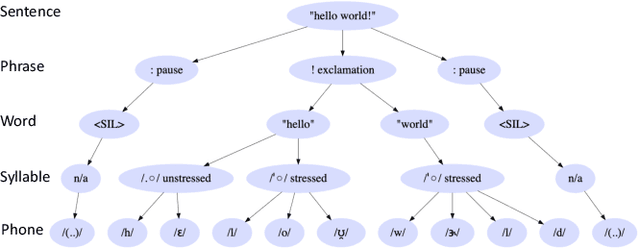
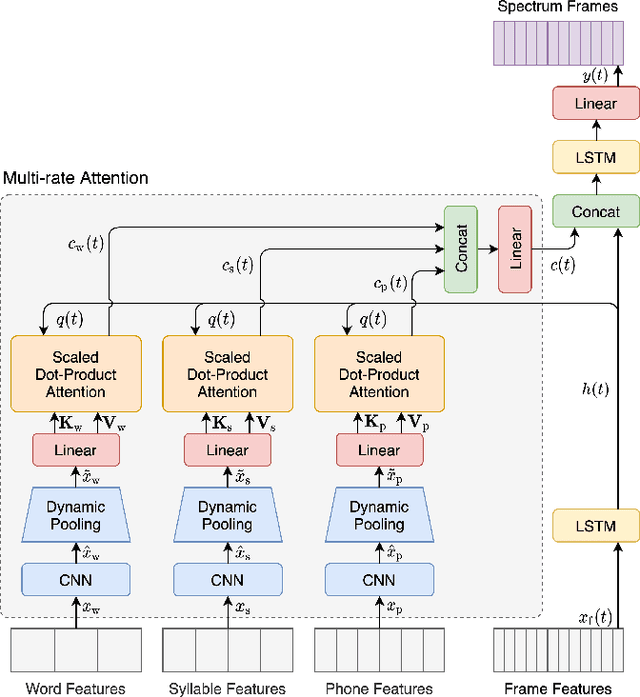
Abstract:Typical high quality text-to-speech (TTS) systems today use a two-stage architecture, with a spectrum model stage that generates spectral frames and a vocoder stage that generates the actual audio. High-quality spectrum models usually incorporate the encoder-decoder architecture with self-attention or bi-directional long short-term (BLSTM) units. While these models can produce high quality speech, they often incur O($L$) increase in both latency and real-time factor (RTF) with respect to input length $L$. In other words, longer inputs leads to longer delay and slower synthesis speed, limiting its use in real-time applications. In this paper, we propose a multi-rate attention architecture that breaks the latency and RTF bottlenecks by computing a compact representation during encoding and recurrently generating the attention vector in a streaming manner during decoding. The proposed architecture achieves high audio quality (MOS of 4.31 compared to groundtruth 4.48), low latency, and low RTF at the same time. Meanwhile, both latency and RTF of the proposed system stay constant regardless of input lengths, making it ideal for real-time applications.
 Add to Chrome
Add to Chrome Add to Firefox
Add to Firefox Add to Edge
Add to Edge